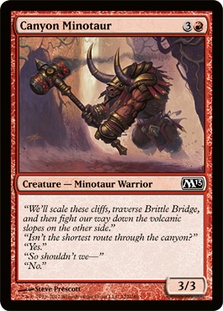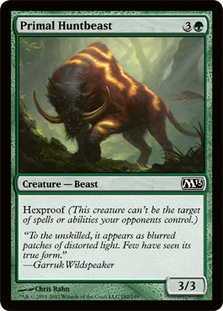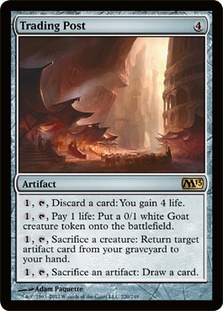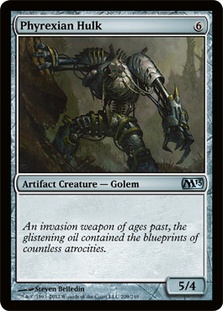I play slightly different cards than other people in Limited. Obviously, we all play the good cards, but I’ve noticed that the bad cards other people play are different than the bad cards I play. When someone asks me to look at their deck and tell them how I’d build it, I often think, "I’m not sure because I never would have drafted a deck that looks like this."
If I’m trying to tell someone how to draft more like me, which is really the closest I can come to giving someone advice since obviously I think I’m drafting correctly, I first need to figure out what we’re doing differently. If we’re doing something the same, you don’t learn anything useful by hearing me tell you to do it, but if I can isolate what you’re doing that is different than what I’m doing, we can at least start to have a useful conversation.
I recently watched Jon Loucks stream some games with a draft deck, and I told him he shouldn’t be playing Canyon Minotaur. He was surprised because he likes Canyon Minotaur. This didn’t make sense to me. What is there to like? He’s like most other creatures, but a little worse. I think to Jon, he fills a role about as well as anyone else, so it doesn’t really matter if you play him or some other four-mana guy. Not to put words in Jon’s mouth or anything, because I could be wrong.
Anyway, I told Jon, "Minotaurs are for sellouts," and in doing so, I think I isolated an important piece of my drafting style. I refuse to sell out.
I have read articles by excellent players about how underrated some random giant durdle is, something like Hexplate Golem or Axegrinder Giant. I heard about how Shuuhei supposedly liked Thraben Purebloods in Innistrad Limited. I played with almost every card in Innistrad, but I’m not sure if I ever cast Thraben Purebloods in my life. I don’t play these cards because I don’t draft them.
I don’t want to play Canyon Minotaur, so why would I draft it? People draft it because they think they might have to play it. I refuse to believe that my deck will be bad enough that I’ll have to play a card I don’t want to play.
What does this mean when drafting?
Well, which is a better card, Canyon Minotaur or Trumpet Blast? I think a lot of people would say Canyon Minotaur is a better card than Trumpet Blast. Most decks would certainly rather have a Canyon Minotaur than a Trumpet Blast. That said, if I see both in pack one and I’m drafting red, I’m taking the Trumpet Blast every single time.
Why would I take Trumpet Blast over Canyon Minotaur if I just said it was the worse card?
When I’m drafting, I often talk about how I take one card over another because it has "high upside." What this means is that it isn’t necessarily the better card or better for my deck, but depending on how the draft goes it has more potential.
When I take the Trumpet Blast, Canyon Minotaur would be better in my deck, but I don’t have to play every card I draft. The Trumpet Blast won’t be in my deck unless I want it there, and if I have a deck with several Krenko’s Commands and Battle Jesters, I expect Trumpet Blast to be amazing, while I can’t imagine a deck where I’d be happy about Canyon Minotaur.
I just finished reading Jeremy Neeman article in which he said Primal Huntbeast is underrated and Roaring Primadox is overrated. Now, I don’t know if he’s saying Primal Huntbeast is better than Roaring Primadox or if he believes that everyone currently thinks Roaring Primadox is much better while he thinks it’s only a little better. What I do know is that I agree with him that Roaring Primadox is probably overrated but that I’d pick Roaring Primadox over Primal Huntbeast.
I don’t know if Roaring Primadox is a better card than Primal Huntbeast.
Actually, let me let you in on a secret. If you ask me which of two cards is better than the other, there’s a very good chance I don’t know the answer. Attended Knight or Griffin Protector, which is better? I have absolutely no idea.
I know that some decks would rather have a Primal Huntbeast and some would rather have a Roaring Primadox. Roaring Primadox is a card that I’m willing to speculate on. I’m not as willing as I used to be, because it generally hasn’t worked out for me, but I will take it over cards that are a little "better" than it early because I know that if everything lines up perfectly it might be one of the best cards in my deck. That can be worth a little gamble. Obviously, I’m not going to take it over a card that will definitely be one of the best cards in my deck, but I do think it’s good to evaluate cards based on the top of their range rather than the middle of their range early in a draft.
Primal Huntbeast is a particularly interesting card to compare it to because Primal Huntbeast, despite looking super solid and consistent, is actually another card that can be a lot better in some decks than others. Specifically, it’s a card with a reasonable baseline, but it becomes awesome as your total number of Mark of the Vampire, Tricks of the Trade, and Ring of Kalonias increase. Roaring Primadox with no synergy at all is likely worse than Primal Huntbeast with no synergy, but it’s kind of close just because Primadox is still a good sideboard card against Pacifism effects. I think Primadox’s peak is higher than Huntbeast’s peak, but I might just be wrong about that.
Honestly, Primal Huntbeast might just be directly better early than Roaring Primadox, which wasn’t really my point, but it’s only true because of niche decks where Huntbeast is king. The Primadox synergies in this set might be so few and far between that it’s just easier to go for the Huntbeast deck.
I got a little derailed there, but the point is while Roaring Primadox is weak enough that you sometimes have to cut it from your deck because you didn’t find the support, I still think it’s reasonable to take pretty early in pack one because it might be awesome. Just don’t get too attached to it and understand that you might not play it at all. It’s ok to waste an early pick. I’ve first picked a red card, drafted a red deck because of that card, then had the rest of the draft take me in a direction where I was no longer the right kind of red deck so I had to just cut the first pick in my color (Magmaquake is a good example of the kind of card that can do this). It’s good to be flexible.
So the first lesson is "Which is better, X or Y?" is a very different question than "Which should I first pick, X or Y?" or "Which should I take for this deck, X or Y?"
As you get familiar with a set, you should start to get a good idea of what you want your decks to look like. If you’re not sure because you can’t find a winning deck, I suggest trying to play in live drafts and asking to see the winning decks after the draft. Try to get a feel for what a winning deck looks like. Think about which cards you want in a winning deck, what you want them to do, and which other cards you need for certain cards to be there. Once you know which cards aren’t important pieces of winning decks, you can start taking "role-players" over cards that you don’t want to have in your deck.
In order to do this safely, it’s important to keep track of how many cards you have that you want to play and how far you are into a draft. I generally feel comfortable if I have around seventeen cards I’d be pretty happy playing going into pack three. If I’m on track to hit that number in the second half of pack two based on what I expect to table given what I passed in the first half of the pack, I know I don’t have to take any "bad cards." Instead of taking Pillarfield Ox and Canyon Minotaurs, I can do things like take Evolving Wilds in my two-color deck just in case I open a bomb I want to splash, or I can take Smelt in case I happen to play against a deck with several important artifacts.
It’s very important to me to have a good sideboard, so I will happily take a sideboard card I think I’m likely to use over a card that I think probably won’t improve my maindeck. (Note the use of the word improve in that sentence rather than the word "make." There’s a chance I’d play the Canyon Minotaur if I had it [there probably isn’t but pretend there is], but if it wouldn’t be relevantly better than the other card I’d play if I didn’t have it, it’s still not worth picking.)
Remember, when you take situational cards (role-players), there are a few different kinds of cards they could be or potential reasons to take them. The most obvious is sideboarding, but the other is just to prepare for your deck to go in a different direction than you expect. If I took a good green card or two early in pack one and then I took eight red cards while thinking I was red/green, I might pick a late Dragon Hatchling over a late Spiked Baloth in pack one, even though Spiked Baloth is better in red/green, because I might find myself moving out of green (and into mono-red, where Dragon Hatchling is pretty good).
To summarize: there are good and bad ways to hedge. You can prepare for the best, or you can prepare for the worst. If you’re looking for the best result, you should probably prepare for the best. This means taking the card with the long-shot huge upside (Roaring Primadox) over the cowardly safe pick. You’ll get what you prepare for.
Changing gears a bit, the other thing I think I do more than less experienced drafters is formulate (and update and evolve) a plan or vision of how my deck is going to look as I draft. I know how I want my deck to win and what kinds of cards it will need to do that.
I’ve learned that M13 is an awesome format because any kind of deck can succeed—you just need to have a plan and find a good way to execute it. I used to think Trading Post was basically unplayable in Draft. Now I’ve played it several games, and I think I’ve won every draft I’ve had it in my deck and don’t think I’ve lost a game with it in play. I just had to learn how to draft the kinds of decks it wants to go in (they’re certainly not the hyper aggressive decks I used to stick to). Phyrexian Hulk looked like a sellout card to me, but it turns out it’s actually just a card with an extremely specific role: it’s there to go late to the Trading Post guy so that he can grind people out with a giant robot that refuses to die.
Tying this into the previous points, as you get later into a draft and surer of what you’re doing, you can avoid cards you’re certain you won’t play for cards you might play. Sometimes this can happen pretty early. For example, say my first pick is Stormtide Leviathan and I spend the first half of pack one drafting Divinations and removal. If at the end of pack one I get a pack with Welkin Tern and Negate, I’m taking the Negate because my control deck just doesn’t want a 2/1 that’s bad at blocking, but I’ll happily sideboard in the Negate in slow matchups. (This is why Welkin Tern and Wind Drake are the two M13 commons I own the fewest of online—all my blue decks are control, and I don’t think those cards do anything for me.)
When I told Jon that Minotaurs are for sellouts, I’d hoped that he was in the right spot to have a minor epiphany: that he would suddenly understand that a 3/3 for four or a 2/2 flier for three just isn’t impressive in modern Magic and that he can aim higher. I don’t know if he did or not, but I hope, with the benefit of this article as more explanation, at least some of you can. Maybe none of us will ever have to cast a Hill Giant again.
Thanks for reading,
Sam
@samuelhblack on Twitter






